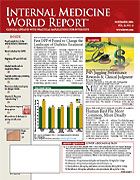Publication
Article
Internal Medicine World Report
Human Bird Flu More Common, More Deadly
Author(s):
From the Infectious Diseases Society of America
TORONTO, Canada—Although avian flu has not reached pandemic status, it is a growing concern worldwide. In 2006, the number of confirmed human cases infected with the H5N1 virus increased significantly, and a larger proportion of infected patients died. In addition, “It is likely that many more human cases of bird flu have been missed, misdiagnosed, or have gone unreported,” said Jeffrey Markowitz, MD, of the Mailman School of Public Health of Columbia University, New York City, at the annual meeting of the Infectious Diseases Society of America.
In 1997, of the 18 people infected with the H5N1 virus in Hong Kong, 6 died.?Since then, the number of outbreaks of this highly pathogenic virus has increased as well as the severity of the outcomes. To date, 256 human cases of avian flu have been confirmed in 10 countries by the World Health Organization (WHO), with the majority occurring in Vietnam, Indonesia, and Thailand.
Among the 256 cases confirmed between the end of 2003 and October 16, 2006, there were 151 deaths, for a case-fatality rate of 59%. By comparison, the deadly 1918 influenza pandemic that killed 50 million to 100 million people worldwide had a case-fatality rate of only 2.5%. However, the 1918 pandemic spread easily between humans.
“The cases confirmed by WHO may be a huge underestimate of the actual number of human bird flu occurrences. Moreover, there is a paucity of information available on what’s actually happening with infected individuals,” said Dr Markowitz. “Are they being treated? If so, with which treatments, and what are their clinical outcomes? If WHO has additional information on human cases, this should be made available to the public and researchers. Physicians may be encountering bird flu patients and may not even know it.”
Little has been published in the biomedical literature regarding the use and effectiveness of antiviral drugs in the current treatment of human cases of avian flu.
A Long Road Ahead
The current investigational H5N1 vaccine has a long way to go before it can be used. It is estimated that by 2008-2009 the production of pandemic flu vaccine will not exceed 2.34 billion doses annually. Current production capacity for seasonal flu vaccine is only 350 million doses, far short of the 6.7 billion world population. In addition, it is expected that a 2-dose vaccination will be needed.
Data presented at the meeting suggest that it may be possible to immunize people in advance of a pandemic, using a single dose of nonadjuvanted vaccine. “This would be a pre-priming strategy,” lead investigator of the vaccine trial, John Treanor, MD, of the University of Rochester, New York, told IMWR. This approach could help kick-start protection against avian flu in advance of a large-scale outbreak.
“That is one of the thoughts that has occurred. Can we prime with a kind of generic H5N1 vaccine and then boost with a strain-specific H5N1?” said Gregory Poland, MD, director, Mayo Vaccine Research Group, and professor of medicine, Mayo Clinic, Rochester. “There is some merit in that, but whether it would work, we just don’t know. My personal thought is that it is less likely to work with inactivated vaccines, but it might with live attenuated vaccines.”
Dr Treanor and colleagues compared the immune response to a single “90-μg dose of 1 variant of avian flu vaccine in 2 groups of adults: those who had received a different variant of H5N1 vaccine some 8 years earlier and those who had not been exposed to any H5N1 virus or vaccines.
More than twice as many individuals who had received the priming dose of H5N1 vaccine responded with substantial antibody levels to a single dose of the study vaccine compared with those who had no previous H5N1 vaccine exposure.
“These preliminary findings need to be confirmed in larger studies, but they offer the intriguing possibility that pre-pandemic priming with existing H5N1 vaccines may boost the immune response to a different H5N1 vaccine tailor-made years later to thwart an emerging human influenza pandemic,” says Anthony S. Fauci, MD, director of the National Institute of Allergy and Infectious Diseases.
Dr Poland noted that wild bird smuggling is second only to drug smuggling in the United States, and this underground network may be importing hawks, fighting birds, and certain types of exotic birds that are infected with the H5N1 virus. This represents yet another route through which the virus could enter North America.






